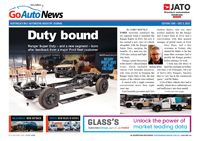Make / Model Search
New models - Lotus - EmiraLotus Emira a petrol swansongEmira the last ‘pure’ petrol Lotus as famed British brand moves to electrification12 Jul 2021 By NEIL DOWLING LOTUS has emerged in 2021 with its first new car of the decade and also the last pure petrol car in the brand’s 73-year history.
The new Emira has been touted as the beginning of a new era for Lotus, ushering in its previously announced move to electric drivetrains.
But that may dismiss how important the Emira is for a few reasons, not least its status as the platform for a burgeoning alliance with Mercedes-Benz.
At the same time the Emira continues a long-standing arrangement between Lotus and Toyota, which started as a technology transfer in 1982 and extended to using the Japanese car-maker’s engines, including the supercharged 3.5-litre V6 that has appeared in the Evora and Exige.
With this 298kW/428Nm engine the Emira takes on rivals including the Porsche 718 Cayman GTS, rated at 220kW/380Nm.
Alongside the Toyota V6, Emira buyers can opt for the Mercedes-AMG M139 2.0-litre turbo-petrol four – also used in the A45 hyper hatch – rated at 268kW/408Nm.
Why the option of the AMG engine? Lotus is concerned that the Toyota V6 may not meet stringent emission regulations coming into Europe in 2027, so it sees room for a more powerful engine in the short term.
The V6 can be paired with a six-speed manual or six-speed torque converter automatic that will appeal to a different audience than the more hard-edged AMG drivetrain.
For performance buyers, the AMG-powered Emira is hard up against other high-spec mid-engined two-seaters, the Porsche 718 Cayman S with a 2.0-litre 220kW/380Nm flat four, and the 215kW/320Nm of the 250kg-lighter Alpine A110S.
The AMG gets an eight-speed dual-clutch transmission – there is no manual – that is substantially punchier than the V6’s two-pedal torque converter option.
Fitted with the AMG engine, the Emira is about 50kg lighter than the V6 version though performance data shows that even with that penalty, the more potent V6 covers 0-100km/h in 4.0 seconds compared with the four-cylinder’s 4.5 seconds.
Externally, the new Lotus picks up many of the hardpoints of the Evora and shares the Coke-bottle hip and broad, low nose.
It has hints of the Evija EV model – intakes behind the side glass and vertical LED headlights, for example – which is understandable given the EV’s design came before the green light for the Emira.
The Emira sits on the same extruded aluminium chassis design first used in the Elise about 25 years ago, now bonded and suited to both transversely mounted engine options.
It has a wider track than the Evora and uses double-wishbones with coilover dampers at the four corners, anti-roll bars front and rear, and the option of suspension settings designed for sporty or touring purposes.
All suspension parts and components are new and not carried over from the Evora. The sport and touring options also bring a change of tyre choice, the latter getting Goodyear Eagle F1 Supersport rubber and the sports version having Michelin Pilot Sport Cup 2s tyres.
Steering remains hydraulically assisted despite the distance from the engine to the steering rack. Lotus remains one of the few sportscar manufacturers that have not gone down the electric-assist route.
Inside, the Emira has a double-deck centre console and supports far more technology than previous Lotus cars. The infotainment and digital systems come from parent company Geely, including a 10.25-inch touchscreen with Apple CarPlay and Android Auto.
It even has cupholders and bottle holders, previously almost unheard of in the brand’s offerings.
The Emira V6 will be the premium model, with UK sources suggesting pricing of about £85,000 (equivalent to $A158,000), to lineball with the Porsche 718 Cayman GTS ($A175,200).
This version will be put into production first at a brand-new facility at Hethel in England and could be available in Australia late 2022. The AMG-engined car is expected to follow and be priced around $A120,000.
Lotus – majority owned by Chinese company Geely that also owns Volvo, Polestar and Proton – said the Emira will be the last pure internal combustion engine sports car to be developed by the company from scratch. This may indicate that a pure EV may be preceded by hybrid models.
It will then turn its attention to its electrification program and work alongside new technical partners including one of its rivals, Alpine.
Lotus currently offers the Exige, Evora and Elise in Australia. Sales this year to date are 31 units, made up of one Evora, 10 Elises and 20 Exiges. The sales figure is up 10.7 per cent on the same period in 2020.  All new modelsMotor industry news |
|

 Alfa Romeo
Alfa Romeo Abarth
Abarth Audi
Audi Aston Martin
Aston Martin BMW
BMW Bentley
Bentley Ferrari
Ferrari Chevrolet
Chevrolet Ford
Ford Fiat
Fiat GWM
GWM Foton
Foton Hyundai
Hyundai Honda
Honda Jaguar
Jaguar Isuzu
Isuzu Kia
Kia Jeep
Jeep Land Rover
Land Rover Lamborghini
Lamborghini Maserati
Maserati Lexus
Lexus McLaren
McLaren Mazda
Mazda Mercedes-Benz
Mercedes-Benz Mitsubishi
Mitsubishi Mini
Mini Peugeot
Peugeot Nissan
Nissan Ram
Ram Porsche
Porsche Rolls-Royce
Rolls-Royce Smart
Smart Skoda
Skoda Suzuki
Suzuki Subaru
Subaru Toyota
Toyota Tesla
Tesla Volvo
Volvo Zeekr
Zeekr







Facebook Twitter Instagram